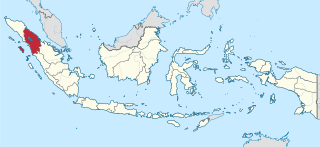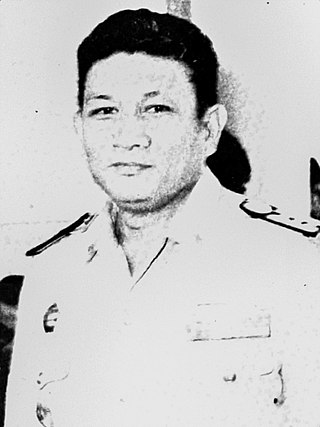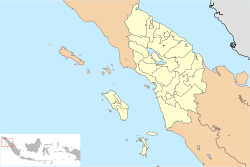
Medan is the capital and largest city of the Indonesian province of North Sumatra. The nearby Strait of Malacca, Port of Belawan, and Kualanamu International Airport make Medan a regional hub and multicultural metropolis, acting as a financial centre for Sumatra and a gateway to the western part of Indonesia. About 60% of the economy in North Sumatra is backed by trading, agriculture, and processing industries, including exports from its 4 million acres of palm oil plantations. The National Development Planning Agency listed Medan as one of the four main central cities in Indonesia, alongside Jakarta, Surabaya, and Makassar.

North Sumatra is a province of Indonesia located in the northern part of the island of Sumatra. Its capital and largest city is Medan. It is bordered by Aceh on the northwest and Riau and West Sumatra on the southeast, with two different coastlines located on the Indian Ocean and the Strait of Malacca, and a maritime border with Malaysia to the east. North Sumatra is Indonesia's fourth most populous province after West Java, East Java, and Central Java, and is also the most populous province outside of Java Island. North Sumatra is also the third-largest province in area on the island of Sumatra after South Sumatra and Riau provinces. It covers an area of 72,460.74 km2, which is approximately the same size as Sierra Leone or Scotland or Maine.

Batak is a collective term used to identify a number of closely related Austronesian ethnic groups predominantly found in North Sumatra, Indonesia, who speak Batak languages. The term is used to include the Karo, Pakpak, Simalungun, Toba, Angkola, and Mandailing, related ethnic groups with distinct languages and traditional customs (adat).

Binjai, formally Kota Binjai, is an independent city in the North Sumatra province of Indonesia, bordered by Deli Serdang Regency to the east and Langkat Regency to the west. Binjai is connected to Medan, about 22 km to the east, by the Sumatra highway that goes to Banda Aceh, and effectively forms a part of Greater Medan. The city's population was 181,904 in the 1990 Census, 224,516 in the 2000 Census, 246,154 in the 2010 Census, and 291,842 in the 2020 Census; the official estimate as of mid-2023 was 303,272, comprising 151,627 males and 151,645 females. In mid-2023, a further 49,217 inhabitants lived in Binjai District of Langkat Regency, outside the city limits but immediately north of the city.

The Karo, or Karonese, are a people of the Tanah Karo and part of the Karo people from North Sumatra, Indonesia. The Karo lands consist of Karo Regency, plus neighboring areas in East Aceh Regency, Langkat Regency, Dairi Regency, Simalungun Regency, and Deli Serdang Regency. In addition, the cities of Binjai and Medan, both bordered by Deli Serdang Regency, contain significant Karo populations, particularly in the Padang Bulan area of Medan. The town of Sibolangit, Deli Serdang Regency in the foothills of the road from Medan to Berastagi is also a significant Karo town.

Tebing Tinggi Deli or more commonly simply Tebing Tinggi is a city near the eastern coast of North Sumatra Province of Indonesia. It has an area of 38.44 km2 and a population at the 2010 Census of 145,180, which grew to 172,838 at the 2020 Census; the official estimate as at mid 2023 was 178,914. Tebing Tinggi is an enclave within Serdang Bedagai Regency, which surrounds it on all sides, and contains a kecamatan (district) bordering the city which is also named Tebing Tinggi.

North Padang Lawas is a landlocked regency in the North Sumatra province of Indonesia. It has an area of 3,918.05 km2, and had a population of 223,049 at the 2010 census and 260,720 at the 2020 census; the official estimate as of mid-2023 was 275,448. North Padang Lawas Regency was created on 17 July 2007 from the eastern parts of the South Tapanuli Regency. Its administrative seat is the town of Gunung Tua.

Simalungun Regency is a regency in North Sumatra Province of Indonesia. Its seat was formerly at Pematangsiantar, but this city was under Law No.15 of 10 March 1986 was separated from the Regency and made into an independent city (kota), although it remains geographically surrounded by the regency, whose new administrative seat is at Raya, while the regency's two most populous districts are Bandar and Siantar. The regency now covers an area of 4,372.5 square kilometres, and at the 2010 census it had a population of 817,720; at the 2020 Census this had risen to 990,246, of whom 497,314 were males and 492,932 were females; the official estimate as at mid 2023 was 1,035,920 - comprising 521,262 males and 514,658 females.

The Simalungun people are an ethnic group in North Sumatra, considered one of the Batak peoples. Simalungun people live mostly in Simalungun Regency and the surrounding areas, including the city of Pematang Siantar, an autonomous city, but previously part of Simalungun Regency.

Toba Batak people are the largest ethnic group of the Batak peoples of North Sumatra, Indonesia. The common phrase of ‘Batak’ usually refers to the Batak Toba people. This mistake is caused by the Toba people being the largest sub-group of the Batak ethnic and their differing social habit has been to self-identify as merely Batak instead of ‘Toba’ or ‘Batak Toba’, contrary to the habit of the Karo, Mandailing, Simalungun, Pakpak communities who commonly self-identify with their respective sub-groups.

The Indonesian island of Sumatra is the sixth largest island in the world. The rich ethnic diversity and historical heritage in Sumatra is reflected in the range of architectural styles in the island. The vernacular style is the native Sumatran ethnic groups architecture of dwellings, while the Hindu-Buddhist architecture reflected through the cultural historical heritage of candis built in Sumatra. The third wave is Islamic architecture adopted in mosques and palace in Sumatra, especially in Aceh, North Sumatra, and Malay cultural sphere in the island.

The East Sumatra revolution, also known as the East Sumatra social revolution, began on 3 March 1946. Across 25 "native states", many sultanates were overthrown and mass killing of members of the aristocratic families were performed by armed pergerakan groups. To the opportunistic pergerakan militants, the revolutionary movement was seen as one of the means for East Sumatra to be freed from colonial overlordship and to join the larger Indonesian National Revolution. Participants of the revolution were believed to be provoked by leaders to kill aristocrats and create violence. These belligerents had three prime objectives: to eliminate the sultans and aristocrats, to seize their wealth and to eliminate the region's feudal social structure. The revolution brought about the formation of the State of East Sumatra, which was dissolved when the region became part of the Indonesian republic.

PanditaRoos Telaumbanua was an Indonesian Nias priest, politician and bureaucrat, who served as the Regent of Nias, acting Mayor of Medan, acting Governor of Sumatra, and the member of People's Representative Council.

Laurimba Saragih was an Indonesian politician and military person who became the Mayor of Pematangsiantar from 25 April 1967 to 28 June 1974.

Radjamin Purba was an Indonesian military officer and politician who served as the Regent of Simalungun from 1960 until 1973.
Urbanus Pardede was an Indonesian Communist and newspaper editor from Sumatra, active both in the Dutch East Indies and independence eras. During the years 1926–30, Dutch authorities arrested him without charge because of his Communist activities and exiled him to the Boven-Digoel concentration camp. He was also a key figure in the East Sumatra revolution of 1946 and became bupati of Simalungan Regency in the early independence era.





























